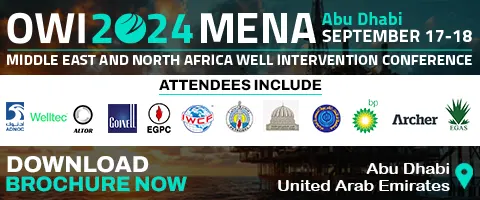In The Spotlight

Aramco awarded US$7.7bn of EPC contracts for the Fadhili Gas Plant expansion during Q1 2024. (Image source: Aramco)
Aramco has reported healthy profits of US27.3bn in the first quarter of 2024, down slightly from the US$31.9bn figure in Q1 2023

Max Brouwers, chief business development officer at Getech, presenting at Innovation Zero. (Image source: Alain Charles Publishing)
The role that hydrogen can play in the drive to net-zero, in particular in decarbonising the hard to abate sectors, is widely recognised

The energy sector is falling far short of ambitious net-zero targets, according to the EIC. (Image source: Adobe Stock)
Stuart Broadley, CEO of the Energy Industries Council (EIC), the global energy trade association, has warned that the energy sector is falling far short of ambitious net-zero targets
-

Rockwell Automation interview with Sebastien Grau
-

Rockwell Automation interview with Michael Sweet
-

ADIPEC 2023 - Exclusive interview with Wissam Chehabi, Fishbones
-

Rockwell Automation interview with Kalypso’s Rodrigo Alves and Knowledge Lens’ Ganesh Iyer
-

ADIPEC 2023 - Exclusive interview with Feby Mohammed, Belden
Chinese companies dominate in Iraq bidding round Chinese companies have won 10 out of the 12 projects awarded so far in the three-day bidding process for the Iraq’s sixth licensing round, according to press reports, with Iraqi Kurdish companies KAR Group winning a further two
Winning bidders are reported to include CNOOC, ZhenHua, Anton Oilfield Services, Sinopec, Geo-Jade, Zhongman Petroleum and Natural Gas Group (ZPEC) and UEG.
Licences for 29 projects are on offer, a key objective being to ramp up output of natural gas for domestic use. Iraq is currently dependent on Iran for much of its gas supply. Iraq is looking to derive more than 3,459mn standard cubic feet of gas per day and over one million barrels of oil per day from these licensing rounds, according to a statement from the office of Prime Minister Mohammed Shia’ al-Sudani.
Iraq is the second largest OPEC oil producer after Saudi Arabia, currently producing around 4.3mn bpd. However, it is yet to harness the full potential of its huge oil and gas reserves, with security concerns and unfavourable contract terms acting as a deterrent to badly needed foreign investment. Gas flaring is also a serious issue. In 2022, the country was the second-largest source of gas flaring worldwide, according to World Bank data, although some initiatives are now underway to capture and use the associated gas rather than flaring it.

Abdulrahman Abdulla Al Seiari, chief executive officer, ADNOC Drilling. (Image source: ADNOC Drilling)
ADNOC Drilling has announced record first quarter revenues of US$886mn, up 24% year-on-year, driven by the offshore jack-up and oilfield services segments
Net profit for the quarter reached US$275mn, up 26% year-on-year.
Revenues from the Offshore Jack-up segment increased by 51% to US$278mn, mainly due to higher activity from the additional jack-up rigs, while the oilfield services segment (OFS) grew 16% year-on-year to US$146mn, driven by increased activity in drilling fluids and directional drilling. The overall volume of activity of the segment is expected to increase throughout the year, in line with planned phasing and driven by IDS rigs ramp-up and unconventionals. Onshore revenue was US$411mn, up 16% year-on-year, mainly due to increased onshore activity, driven by the contribution from new rigs commencing operations.
Major contract
Highlights of the quarter include the award of a US$1.7bn contract to provide drilling and associated services for the recovery of unconventional energy resources, whereby ADNOC Drilling will drill 144 unconventional oil and gas wells. ADNOC Drilling will leverage the technology pipeline of its strategic joint venture Enersol and ADNOC’s AI, digitisation, and advanced technologies capabilities
At the end of the first quarter 2024, ADNOC Drilling’s fleet comprised 137 rigs, an increase of 22 rigs year-on-year. Thirteen of these are hybrid powered land rigs that utilise battery storage to improve power delivery and reduce emissions by up to 15% per rig. An additional three hybrid land rigs are expected to enter the fleet this year.
Abdulrahman Abdulla Al Seiari, chief executive officer, ADNOC Drilling, said, “Our strong first quarter performance demonstrates that we have entered a new era for the company as we go from strength-to-strength. Our multi-faceted strategy of enabling ADNOC’s conventional and unconventional production capacity growth to meet the world’s growing demand for energy will further transform the business in 2024-onwards. The US$1.7bn contract award represents a transformational opportunity as the UAE’s world class unconventional energy resources will require many thousands of wells and we are in prime position to deliver them. Aligned to this is the investment in, and adoption of, artificial intelligence and advanced technologies through our strategic joint venture, Enersol, that has a US$1.5bn mandate to invest in and acquire global energy technologies.”
Honeywell has launched a new process to improve the efficiency and sustainability of light olefin production
The naphtha to ethane and propane (NEP) technology generates a tunable amount of ethane and propane from naphtha and/or LPG feedstocks, generating more high-value ethylene and propylene with reduced production of lower-value by-products compared to a traditional mixed-feed steam cracking unit and resulting in net cash margin increases. An NEP-based olefins complex also reduces CO2 intensity per metric ton of light olefins produced by 5 to 50% versus a traditional mixed-feed steam cracker.
More efficient production
“The petrochemical industry faces strong competition and challenges in obtaining raw materials globally,” said Matt Spalding, vice president and general manager of Honeywell Energy and Sustainability Solutions in MENA. “Our technology helps to enable more efficient production of ethylene and propylene, two chemicals which are in high demand, while also helping our customers lower their carbon emissions.”
The new solution is a part of Honeywell’s Integrated Olefin Suite technology portfolio to enhance the production of light olefins.
Halliburton has introduced SentinelCem Pro cement system to help customers address losses while drilling
SentinelCem Pro cement simplifies mixing operations by eliminating the need for pre-hydration of the slurry design and access to high-purity water sources. This feature facilitates more efficient rig operations with the option to direct mix the system on-the-fly or in a batch mixer. The single-sack packaging facilitates storage in offshore and remote locations.
The thixotropic nature of SentinelCem Pro cement allows the system to stay fluid while pumped into lost-circulation zones and to rapidly gel when pumping stops. This feature enables the system to penetrate deep into fractures and vugular formations to mitigate costly drilling fluid loss to the formation. The system’s early compressive strength development enables a quick return to drilling operations.
Portfolio addition
The SentinelCem Pro system is an addition to Halliburton’s lost circulation portfolio, which addresses a wide range of lost circulation issues. Lost circulation is commonly encountered in drilling and cementing operations and can be a costly challenge to overcome.
“Lost circulation is the main contributor to costly nonproductive time (NPT) in well construction,” said Matt Lang, vice president of Cementing, Halliburton. “SentinelCem Pro cement safely pumps through the bottom-hole-assembly to help customers quickly address lost circulation events and reduce NPT."
More than 175 people, including senior representatives of the region's leading oil and gas companies, attended a very topical and engaging live webinar hosted by Oil Review Middle East entitled “Beyond Boundaries: Advanced Surveillance for Oil and Gas Remote Facilities”
Thomas Evans, Origination Lead EMEA at global professional services company GHD discusses the prospects for scaling up hydrogen development in the MENA region
How do you view prospects for advancing hydrogen development in the region, and what role will the UAE's National Hydrogen strategy play in advancing hydrogen development in the UAE?
The prospects for advancing hydrogen development in the region are extremely promising. Particularly in the Middle East, countries not only have access to abundant natural resources but also possess significant investment capabilities and expertise in attracting international businesses and talent. Combined with economic stability, the region is well positioned as a global leader in low-carbon hydrogen production and innovation.
Developed in alignment with the UAE’s Centennial 2071 ambition, the UAE's National Hydrogen Strategy provides a comprehensive roadmap for establishing a successful hydrogen economy. A key focus of the strategy is on generating and supporting a domestic hydrogen market. While there may be a temptation to concentrate on production capabilities, understanding and developing domestic demand is crucial. The strategy recognises that although the technology for hydrogen export is still evolving, successful and economically sustainable hydrogen economies should first focus on their domestic markets, with the potential for international exports in the mid to long term.
The UAE's strategy also stresses the need for the integration of various hydrogen production technologies. It considers the use of blue hydrogen (derived from natural gas with carbon capture, utilisation, and storage (CCUS)), green hydrogen (produced from renewable sources), and other emerging technologies to meet its ambitious targets. A diverse technological approach will be key to advancing hydrogen development.
What are the main challenges to scaling up hydrogen development, and how can these be tackled?
Scaling up hydrogen development presents several challenges, particularly when examining the context of the UAE’s hydrogen industry.
Most importantly, there is a need for clear governance and regulatory frameworks to facilitate the growth of the hydrogen economy. We can draw valuable lessons from international examples such as the US Inflation Reduction Act, the UK Hydrogen Business Model, and EU policies like Fit for 55 and the European Hydrogen Bank. Establishing such frameworks will help remove barriers and provide more investment opportunities, propelling the hydrogen strategy forward.
The CAPEX and OPEX for low-carbon hydrogen production are currently high. Without effective market mechanisms, hydrogen is unable to compete on price with natural gas and other fossil fuels. Addressing this challenge requires the implementation of policies and incentives that can lower costs and make hydrogen more competitive. Having said this, we have seen CAPEX prices decreasing in the last 2 years by around 25% to 30% which is a positive sign for the industry.
The low-carbon hydrogen offtake market is still immature. In the UAE, there is a significant opportunity to become a leader in domestic hydrogen usage and the production of high-value green products for both export and domestic markets, such as green steel. However, there is a degree of "progress paralysis" globally, due to uncertainties about the growth rate of the hydrogen offtake market. Developing a robust domestic demand is crucial in the short term, as it helps de-risk investments by providing a guaranteed market for hydrogen products.
Supply chain constraints represent both an opportunity and a challenge for the UAE’s hydrogen economy. Currently, the global supply chain is under pressure, with long lead times and slower than anticipated technology learning rates. Strengthening the local supply chain can alleviate these issues.
Read the full interview in the latest issue of the magazine, at https://oilreviewmiddleeast.com/magazines/orme_2024_05_02/spread/?page=18



























































